2017 PEUGEOT 4008 tow
[x] Cancel search: towPage 7 of 368
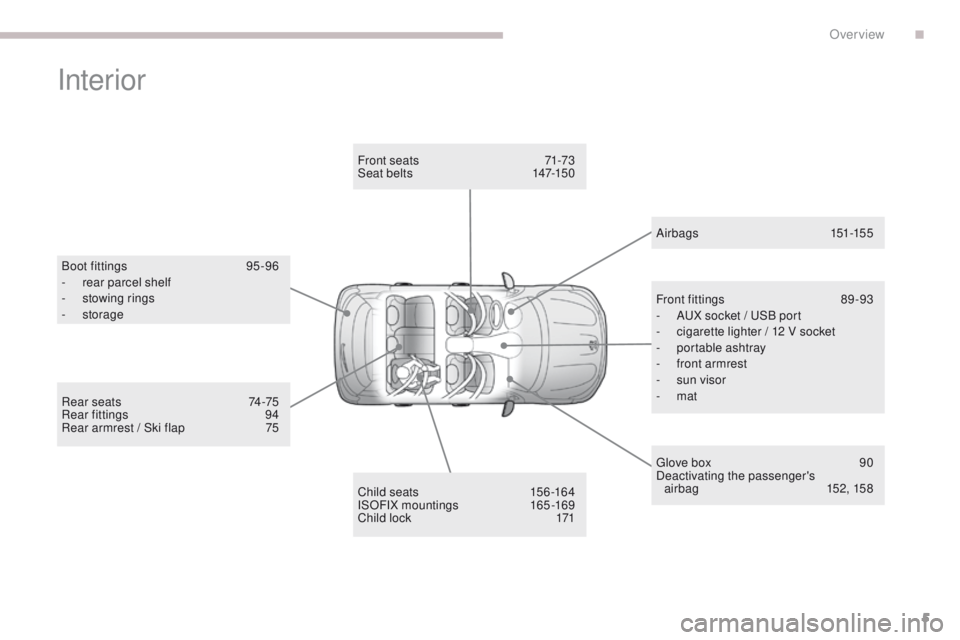
5
4008_en_Chap00b_vue-ensemble_ed01-2016
Interior
Boot fittings 95 -96
- r ear parcel shelf
-
s
towing rings
-
storage
Child seats
1
56 -164
ISOFIX mountings
1
65-169
Child lock
1
71
Front seats
7
1-73
Seat belts
1
47-150
gl
ove box
9
0
Deactivating the passenger's air bag
15
2, 15 8
A ir bags
151-155
Front fittings
8
9 -93
-
AuX s
ocket / u
S
B port
-
c
igarette lighter / 12 V socket
-
p
ortable ashtray
-
f
ront armrest
-
s
un visor
-
mat
Rear seats
7
4-75
Rear fittings
9
4
Rear armrest / Ski flap
7
5
.
Over view
Page 12 of 368

10
4008_en_Chap00c_eco-conduite_ed01-2016
eco-drivingeco-driving is a range of everyday practices that allow the motorist to optimise their fuel consumption and CO2 emissions.
Optimise the use of your gearbox
With a manual gearbox, move off gently and change up without waiting.
During acceleration, change up early.
With an automatic gearbox, give preference to automatic mode and
avoid pressing the accelerator pedal heavily or suddenly.
th
e gear shift indicator invites you to engage the most suitable gear:
as soon as the indication is displayed in the instrument panel, follow it
straight away.
For vehicles fitted with an automatic gearbox, this indicator appears
only in manual mode.
Drive smoothly
Maintain a safe distance between vehicles, use engine braking rather
than the brake pedal, and press the accelerator progressively. th ese
practices contribute towards a reduction in fuel consumption and CO
2
emissions and also help to reduce the background traffic noise.
Control the use of your electrical
equipment
Before moving off, if the passenger compartment is too warm, ventilate it
by opening the windows and air vents before using the air conditioning.
Above 30 mph (50 km/h), close the windows and leave the air vents
open.
Remember to make use of equipment that can help keep the
temperature in the passenger compartment down (sunroof, window
blinds, etc.).
Switch off the air conditioning, unless it has automatic regulation, as
soon as the desired temperature is attained.
Switch off the demisting and defrosting controls, if not automatic.
Switch off the heated seat as soon as possible.
Switch off the headlamps and front foglamps when the level of light
does not require their use.
Avoid running the engine before moving off, particularly in winter; your
vehicle will warm up much faster while driving.
As a passenger, if you avoid connecting your multimedia devices
(film, music, video game, etc.), you will contribute towards limiting the
consumption of electrical energy, and so of fuel.
Disconnect your portable devices before leaving the vehicle.
If your vehicle has cruise control, make use of the system at speeds
above 25 mph (40 km/h) when the traffic is flowing well.
eco-driving
Page 18 of 368

16
Operation indicator lamps
If one of the following indicator lamps comes on, this confirms that the corresponding system has come into operation.
It may be accompanied by an audible signal and a message in the instrument panel screen.Warning /indicator lampis on Cause Action / Observations
Left-hand
direction
indicator flashing with audible
warning.
th
e lighting stalk has been pressed
downwards. If this indicator lamp flashes abnormally quickly, this
could indicate that the bulb of one of the direction
indicators has blown. Change the bulb or contact a
P
e
uge
Ot
dealer or a qualified workshop.
Right-hand
direction
indicator flashing with audible
warning.
th
e lighting stalk has been pushed
upwards. If this indicator lamp flashes abnormally quickly, this
could indicate that the bulb of one of the direction
indicators has blown. Change the bulb or contact a
P
e
uge
Ot
dealer or a qualified workshop.
Sidelamps or
dipped beam
headlamps fixed.
th
e sidelamps or dipped beam
headlamps are on.
Main beam
headlamps fixed.
th
e lighting stalk is pulled towards
you. Pull the stalk to return to dipped beam headlamps.
Front foglamps fixed.
th
e front foglamps are switched on
using the ring on the lighting control
stalk.
tu
rn the ring on the lighting control stalk rear ward
once to switch off the front foglamps.
Rear foglamp sfixed.
th
e rear foglamps are switched on.
tu
rn the ring on the stalk rear ward to switch off the
rear foglamps.
Instruments
Page 61 of 368
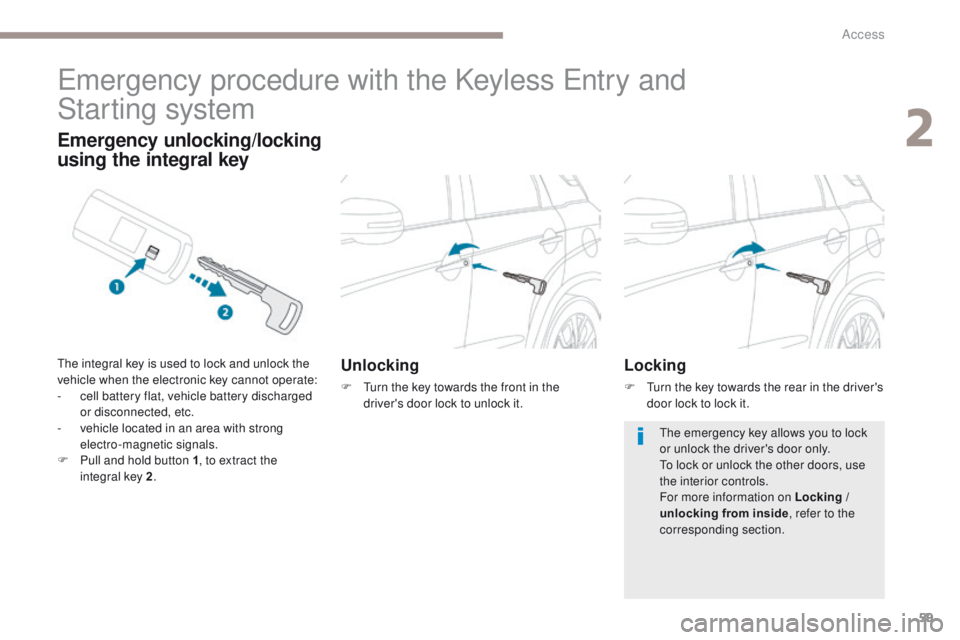
59
4008_en_Chap02_ouvertures_ed01-2016
emergency procedure with the Keyless en try and
Star ting system
Unlocking
F turn the key towards the front in the
driver's door lock to unlock it.
Emergency unlocking/locking
using the integral key
the integral key is used to lock and unlock the
vehicle when the electronic key cannot operate:
-
c
ell battery flat, vehicle battery discharged
or disconnected, etc.
-
v
ehicle located in an area with strong
electro-magnetic signals.
F
P
ull and hold button 1 , to extract the
integral key 2 .Locking
F turn the key towards the rear in the driver's
door lock to lock it.
th
e emergency key allows you to lock
or unlock the driver's door only.
to l
ock or unlock the other doors, use
the interior controls.
For more information on Locking /
unlocking from inside , refer to the
corresponding section.
2
Access
Page 66 of 368
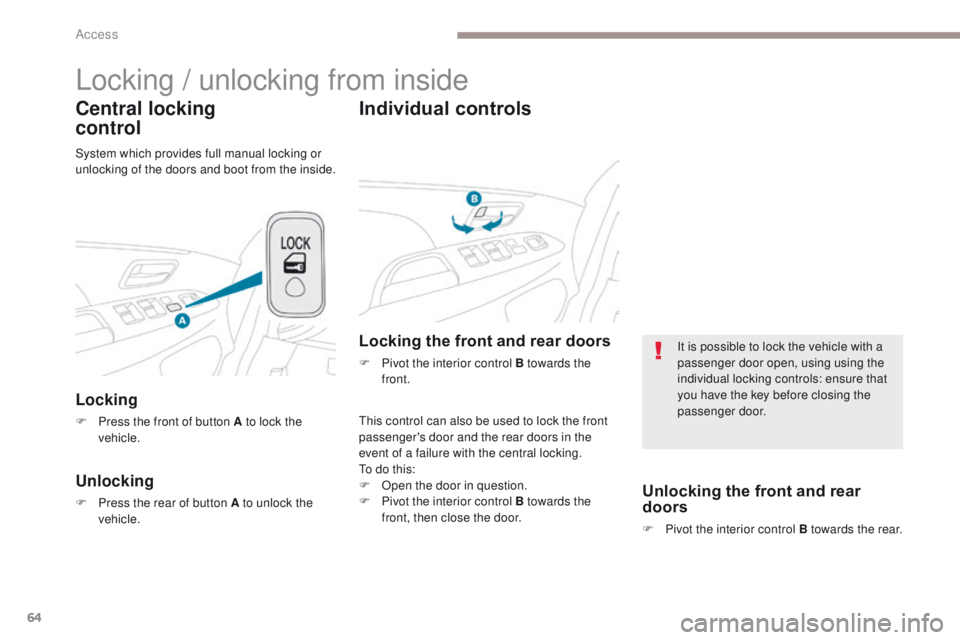
64
4008_en_Chap02_ouvertures_ed01-2016
Locking / unlocking from inside
Central locking
control
Locking
F Press the front of button A to lock the vehicle.
Unlocking
F Press the rear of button A to unlock the vehicle.
Individual controls
this control can also be used to lock the front
passenger's door and the rear doors in the
event of a failure with the central locking.
to d
o this:
F
O
pen the door in question.
F
P
ivot the interior control B towards the
front, then close the door.
Locking the front and rear doors
F Pivot the interior control B towards the front.
System which provides full manual locking or
unlocking of the doors and boot from the inside.
Unlocking the front and rear
doors
F Pivot the interior control B towards the rear.
It is possible to lock the vehicle with a
passenger door open, using using the
individual locking controls: ensure that
you have the key before closing the
passenger door.
Access
Page 69 of 368

67
4008_en_Chap02_ouvertures_ed01-2016
Triggering of the alarm
this is indicated by sounding of the siren
and flashing of the direction indicators for
thirty
seconds.
A message then appears in the instrument
panel screen while the siren is operating.
When the ignition is next switched on
(ON
mode if your vehicle has the "Keyless
en
try and Starting" system), an audible signal
sounds four times to inform you that the alarm
was triggered during your absence.
Complete deactivation of
the alarm
F Switch off the ignition (OFF mode if your vehicle has the "Keyless en try and
Starting" system).
F
R
emove the key from the ignition switch,
if your vehicle does not have the "Keyless
en
try and Starting" system.
F
O
pen the driver's door.
F
P
lace the lighting control stalk in
the
"OFF "
position.
F
P
ull the wiper control stalk towards you and
hold.
A
fter about ten seconds there is an audible
signal.
F
W
hen the audible signal stops, continue to
hold the wiper stalk pulled towards you and
press the remote control locking button.
You can completely deactivate the alarm
system.
t
o d
o this, proceed as follows:
F th e state of the system is then signalled to
you by the number of beeps:
O
ne beep: the alarm system is completely
deactivated.
t
w
o beeps: the alarm system is activated.
e
a
ch new press of the remote control
locking button changes the state of the
system.
2
Access
Page 77 of 368
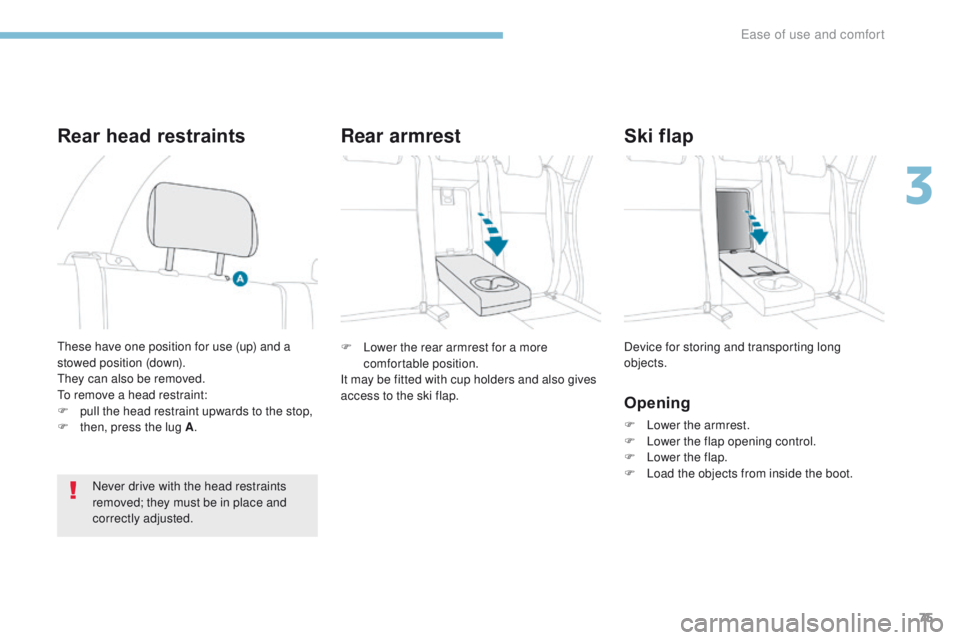
75
4008_en_Chap03_Ergonomie-et-confort_ed01-2016
F Lower the rear armrest for a more comfortable position.
It may be fitted with cup holders and also gives
access to the ski flap. Device for storing and transporting long
objects.
Opening
F Lower the armrest.
F
L ower the flap opening control.
F
L
ower the flap.
F
L
oad the objects from inside the boot.
th
ese have one position for use (up) and a
stowed position (down).
th
ey can also be removed.
to r
emove a head restraint:
F
p
ull the head restraint upwards to the stop,
F
t
hen, press the lug A .
Rear head restraints Rear armrestSki flap
Never drive with the head restraints
removed; they must be in place and
correctly adjusted.
3
ease of use and comfort
Page 82 of 368
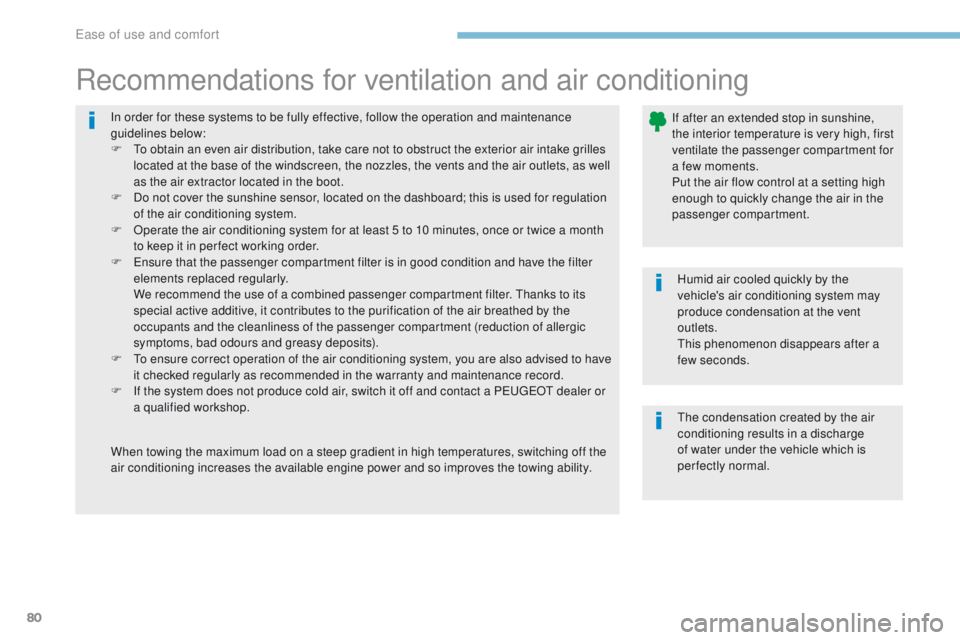
80
4008_en_Chap03_Ergonomie-et-confort_ed01-2016
In order for these systems to be fully effective, follow the operation and maintenance
guidelines below:
F t
o o
btain an even air distribution, take care not to obstruct the exterior air intake grilles
located at the base of the windscreen, the nozzles, the vents and the air outlets, as well
as the air extractor located in the boot.
F
D
o not cover the sunshine sensor, located on the dashboard; this is used for regulation
of the air conditioning system.
F
O
perate the air conditioning system for at least 5 to 10 minutes, once or twice a month
to keep it in per fect working order.
F
e
n
sure that the passenger compartment filter is in good condition and have the filter
elements replaced regularly.
W
e recommend the use of a combined passenger compartment filter. t
h
anks to its
special active additive, it contributes to the purification of the air breathed by the
occupants and the cleanliness of the passenger compartment (reduction of allergic
symptoms, bad odours and greasy deposits).
F
t
o e
nsure correct operation of the air conditioning system, you are also advised to have
it checked regularly as recommended in the warranty and maintenance record.
F
I
f the system does not produce cold air, switch it off and contact a P
e
uge
Ot
dealer or
a qualified workshop.
Recommendations for ventilation and air conditioning
If after an extended stop in sunshine,
the interior temperature is very high, first
ventilate the passenger compartment for
a few moments.
Put the air flow control at a setting high
enough to quickly change the air in the
passenger compartment.
Humid air cooled quickly by the
vehicle's air conditioning system may
produce condensation at the vent
outlets.
th
is phenomenon disappears after a
few seconds.
When towing the maximum load on a steep gradient in high temperatures, switching off the
air conditioning increases the available engine power and so improves the towing ability.
th
e condensation created by the air
conditioning results in a discharge
of water under the vehicle which is
perfectly normal.
ease of use and comfort